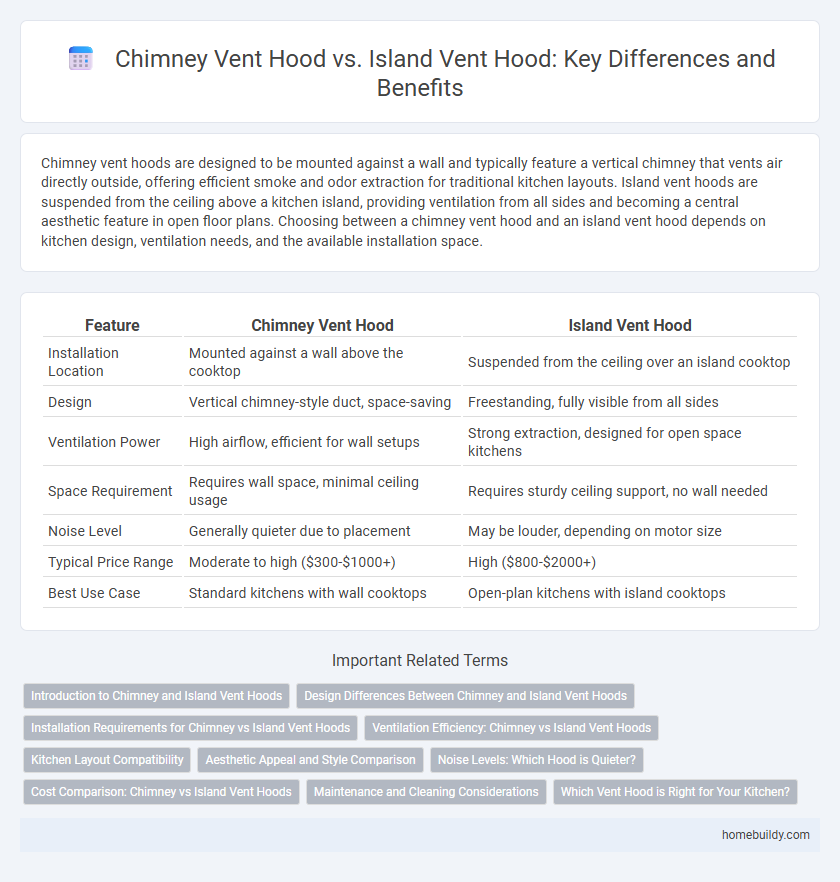Chimney vent hoods are designed to be mounted against a wall and typically feature a vertical chimney that vents air directly outside, offering efficient smoke and odor extraction for traditional kitchen layouts. Island vent hoods are suspended from the ceiling above a kitchen island, providing ventilation from all sides and becoming a central aesthetic feature in open floor plans. Choosing between a chimney vent hood and an island vent hood depends on kitchen design, ventilation needs, and the available installation space.
Table of Comparison
| Feature | Chimney Vent Hood | Island Vent Hood |
|---|---|---|
| Installation Location | Mounted against a wall above the cooktop | Suspended from the ceiling over an island cooktop |
| Design | Vertical chimney-style duct, space-saving | Freestanding, fully visible from all sides |
| Ventilation Power | High airflow, efficient for wall setups | Strong extraction, designed for open space kitchens |
| Space Requirement | Requires wall space, minimal ceiling usage | Requires sturdy ceiling support, no wall needed |
| Noise Level | Generally quieter due to placement | May be louder, depending on motor size |
| Typical Price Range | Moderate to high ($300-$1000+) | High ($800-$2000+) |
| Best Use Case | Standard kitchens with wall cooktops | Open-plan kitchens with island cooktops |
Introduction to Chimney and Island Vent Hoods
Chimney vent hoods are wall-mounted units designed to efficiently capture smoke and grease, featuring a vertical duct that directs airflow outside through the ceiling or wall. Island vent hoods hang from the ceiling above kitchen islands, providing ventilation for cooking areas without adjacent walls, typically equipped with powerful fans and larger capture areas to manage open space airflow. Both systems enhance indoor air quality by removing cooking emissions, but their installation depends on kitchen layout and ventilation needs.
Design Differences Between Chimney and Island Vent Hoods
Chimney vent hoods feature a vertical design attached to a wall, extending from the stove to the ceiling, offering a streamlined and space-saving aesthetic ideal for kitchens with limited overhead space. Island vent hoods are ceiling-mounted and suspend over a cooking island, designed to provide ventilation from above without relying on wall support, often resulting in a more prominent, statement-making presence. The structural differences influence installation complexity, airflow efficiency, and visual impact, with chimney hoods emphasizing integration and island hoods focusing on central visibility and access.
Installation Requirements for Chimney vs Island Vent Hoods
Chimney vent hoods require wall mounting and a vertical duct run, necessitating proximity to an external wall or additional construction for venting through ceilings or roofs. Island vent hoods demand ceiling installation with a dedicated and often longer duct path to the roof, requiring robust ceiling support to accommodate the unit's weight. Both installations must ensure proper clearance and ventilation codes compliance for optimal performance and safety.
Ventilation Efficiency: Chimney vs Island Vent Hoods
Chimney vent hoods typically offer superior ventilation efficiency due to their direct vertical exhaust route, which minimizes air resistance and enhances smoke and odor removal. Island vent hoods, while aesthetically designed for central kitchen placement, may require more powerful fans to achieve comparable airflow because of their horizontal ducting and potential for increased air turbulence. Evaluating the kitchen layout and ventilation needs is crucial to selecting the optimal vent hood for maximum performance.
Kitchen Layout Compatibility
Chimney vent hoods are ideal for kitchens with wall-mounted cooktops, offering a streamlined ventilation solution that integrates smoothly with traditional layouts. Island vent hoods suit open-concept kitchens where cooking islands are centrally located, providing overhead extraction without obstructing sightlines. Choosing between these vent hoods depends heavily on the kitchen layout, as chimney hoods require wall installation, while island hoods demand ceiling mounting above the island.
Aesthetic Appeal and Style Comparison
Chimney vent hoods feature a traditional vertical design that complements classic kitchen aesthetics, often becoming a focal point with their sleek, extended chimney structure. Island vent hoods offer a modern and open style, designed to hang from the ceiling above a kitchen island, providing a symmetrical and balanced look that enhances contemporary or minimalist spaces. Both styles come in various finishes and materials, allowing customization to match cabinetry and overall kitchen decor.
Noise Levels: Which Hood is Quieter?
Chimney vent hoods generally operate more quietly than island vent hoods due to their compact design and proximity to external walls, which allows for more efficient noise reduction and venting. Island vent hoods often produce higher noise levels because they require more powerful fans to expel air through longer ductwork, increasing motor and airflow sounds. Choosing a chimney vent hood can significantly decrease kitchen noise, enhancing overall cooking comfort.
Cost Comparison: Chimney vs Island Vent Hoods
Chimney vent hoods typically cost between $300 and $1,500, with installation expenses ranging around $200 to $500 due to wall mounting. Island vent hoods are generally more expensive, priced from $600 to $2,500, largely because of ceiling mounting and the need for reinforced ductwork. Homeowners should consider these cost differences along with kitchen layout when choosing between chimney and island vent hoods.
Maintenance and Cleaning Considerations
Chimney vent hoods typically require less frequent cleaning due to their vertical ductwork that efficiently channels grease and smoke upward, reducing buildup. Island vent hoods, positioned above cooking islands, often collect more grease and require more regular maintenance to prevent residue accumulation because of their exposure on all sides. Selecting a vent hood with easily removable filters and accessible surfaces simplifies cleaning and prolongs efficient ventilation performance.
Which Vent Hood is Right for Your Kitchen?
Chimney vent hoods are ideal for kitchens with wall-mounted stoves, offering powerful ventilation and a sleek, vertical design that directs smoke and odors upward efficiently. Island vent hoods are designed for cooktops located on kitchen islands, providing 360-degree ventilation with a suspended design that enhances open-concept layouts. Choosing the right vent hood depends on kitchen layout, cooking habits, and aesthetic preferences, ensuring optimal air quality and style integration.
Chimney vent hood vs Island vent hood Infographic

 homebuildy.com
homebuildy.com